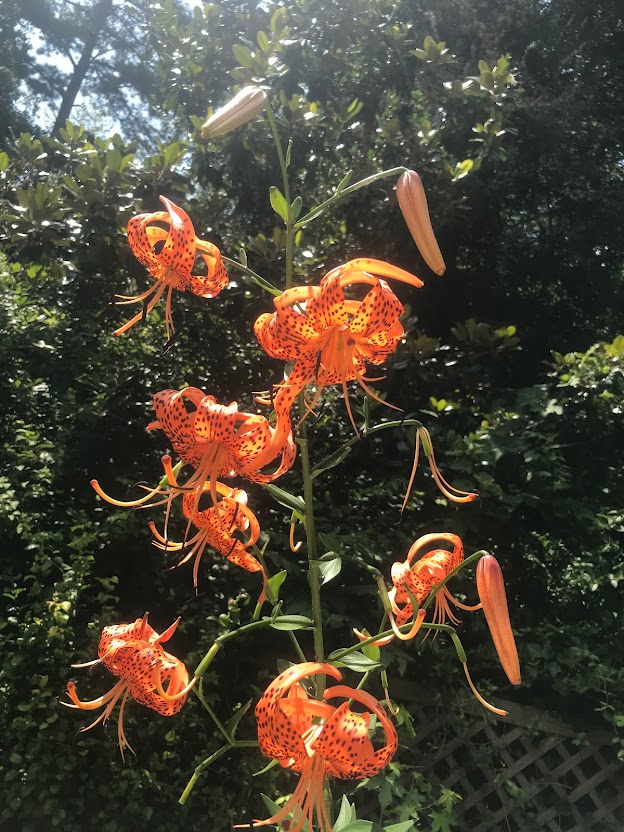Bogturtle's Garden- August 1-15, 2023
Just typical of what I see, every morning, checking the SDHC cards. Really could not publish videos before. As those lasted 20 seconds and this system could not handle that, but these new ones are only 10 seconds long.
Lilium tigrinum, again. Originally, several of the little bulbils, that form where leaves attach to the stem, were picked off a neighbors plant. They had, already, the tiny start of a root on them.
Bignonia capreolata, the native Crossvine, also just produces a few flowers all Summer. An amazing show in Spring, but it must be planted so it will not climb to the top of some tree. It will bloom there, out of sight. The other Honeysuckle is L. perclymenum, I think. A European species. That one is fragrant. The lattice that hides the above ground pool from where we park the vehicles has the pool side to the South, so a lot of vines bloom at the side of the pool.
A lifetime of observing NJ wildlife, employment at a wildlife refuge and teaching Bio for over 30 years, and I have never seen this bird. Looks like the Spotted Sandpiper shown in my 'Field Guide to the Birds'.
Easily entertained. The Spaghetti Squash are a wash, this year. All the work and expense of rototilling, raising the little plants, and the Deer have gotten to them twice. Many a S. Jersey serious farmer has 6 foot high, heavy wire fencing, as growing some crops is impossible otherwise. I will not, at this point, expand the fencing I have.
But the Deer could not reach one part of one plant that is growing up into the Japanese Apricot tree, Prunus mume, and one small squash is ripening. The squash gets quite large and heavy, so we will see what happens.
Such beautiful pests. And I had no idea there were so many. I think the date and time is accurate. The videos are about 10 seconds long, that varying with battery strength. I don't know how long they could be, but do know 20 seconds long will not download to this blog.
All the herbs out behind the house, and one senseless pot of Lysmachia nummelaria, the Moneywort. Another plant that, once introduced, you will always have. Amazing that I recall the first time I saw this obscure little plant, off in the bushes, on a hike in the Great Swamp, in N. Jersey. Before I was out of college, I think. Once set aside as a site for an airport, but now protected. A bullet dodged. Nice yellow flowers, but the moneywort has plans of taking over the planet. Another pot has Platycodon mariesii. The commonest violet flowered form of this dependable perennial. I should just move it to the main perennial bed. Always seem to be room, after I get into aggressive weeding, as some unwanted losses of valuable plants always seems to come.The green grassy Chives have been replanted, and has responded immediately. The two pots, Flat Leaved Italian Parsley and Dill, are recent. My mind goes to the black Anise Swallowtail Butterflies that love both. Gardening is never what a newby envisions. I did let one hang its crysalis up and turn into a butterfly. Very interesting. The Basil is doing fine, while always going to bloom. I try to keep up with picking off the budding stems. The white plastic window box was seeded withThyme about 4 years ago.
The few pale violet flowers on the trailing Rosemary herb are evidence that it is thriving.
'Happy Returns' Daylily is sending out a few blooms, after its massive Spring display. Locally, daylily plantings must have underground irrigration or daily watering. Mine, in this sandy soil, get brownish leaves mixed in. Still worth having.
All the dark foliage on the Red Knockout Roses shows that they are doing fine, after fertilizer and mulch, and, of course, spray with Deer repellent. Soon to be a mass of bloom, as they were in late May.
A perennial Veronica, of the typical blue violet, and new this year. Replacing the sort called 'Sunny Border Blue'. So busy that I have, actually, lost sorts due to neglect.
One single munching session by the Deer took away the bloom, and nearly the survival, of most clones of Phlox paniculata. But these few blooms of the more dwarf form called 'Minnie Pearl' escaped, and bloom among the overgrowth in the main perennial bed. Otherwise magnificently dependable additions. Never before have the Deer been bold enough to come in front of the vehicles near the screened porch.
The old fashioned Pee Gee Hydrangea. Well established now as a fine little tree at the start of the front walk. I liked two I saw along local roads. This started, years ago, as a foot tall $2.50 purchase at the local nursery, where the owner said she was happy to make a dollar or two, while in competition with a similar place down the highway. They are gone, now and her business is thriving.
This plant hangs in the little Shadbush tree over the exit from where we park.
I believe this is an edible bean, but often, especially in Britain, used as an ornamental vine. Never tried to cook them. The Scarlet Runner Bean would be another candidate for a major display, yet I have very few growing, this year. I think a container of saved seed is around and am curious how long they would be able to germinate. But, just in case, if any pods come from the blooms shown, I will save the seed.


















.JPG)
We had a fox coming a few months ago but haven't seen him/her in a while.
ReplyDeleteA priviledge to see one in the day. I recall, years ago, hearing their sharp bark, not knowing what it was. I would know it now.
Delete